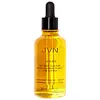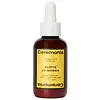What's inside
What's inside
 Key Ingredients
Key Ingredients

 Benefits
Benefits

 Concerns
Concerns

 Ingredients Side-by-side
Ingredients Side-by-side

Squalane
EmollientHydrogenated Farnesene
EmollientBisabolol
MaskingOcimum Basilicum Hairy Root Culture Extract
Skin ConditioningOryza Sativa Bran Extract
Skin ConditioningCocos Nucifera Oil
MaskingCurcuma Longa Root Extract
MaskingHelianthus Annuus Extract
EmollientTocopherol
AntioxidantRosmarinus Officinalis Leaf Extract
AntimicrobialHelianthus Annuus Seed Oil
EmollientMoringa Oleifera Seed Oil
EmollientMelia Azadirachta Flower Extract
Skin ConditioningMelia Azadirachta Bark Extract
AntimicrobialOcimum Sanctum Leaf Extract
Skin ConditioningCorallina Officinalis Extract
Skin ConditioningOcimum Basilicum Flower/Leaf Extract
TonicMelia Azadirachta Extract
Skin ConditioningCitrus Reticulata Peel Oil
MaskingJasminum Officinale Oil
MaskingMelia Azadirachta Leaf Extract
Skin ConditioningParfum
MaskingLimonene
PerfumingLinalool
PerfumingSqualane, Hydrogenated Farnesene, Bisabolol, Ocimum Basilicum Hairy Root Culture Extract, Oryza Sativa Bran Extract, Cocos Nucifera Oil, Curcuma Longa Root Extract, Helianthus Annuus Extract, Tocopherol, Rosmarinus Officinalis Leaf Extract, Helianthus Annuus Seed Oil, Moringa Oleifera Seed Oil, Melia Azadirachta Flower Extract, Melia Azadirachta Bark Extract, Ocimum Sanctum Leaf Extract, Corallina Officinalis Extract, Ocimum Basilicum Flower/Leaf Extract, Melia Azadirachta Extract, Citrus Reticulata Peel Oil, Jasminum Officinale Oil, Melia Azadirachta Leaf Extract, Parfum, Limonene, Linalool
Limnanthes Alba Seed Oil
Skin ConditioningCoconut Alkanes
EmollientSalvia Hispanica Seed Oil
MoisturisingOrbignya Oleifera Seed Oil
EmollientBrassica Campestris Seed Oil
Skin ConditioningOenocarpus Bataua Fruit Oil
EmollientCrambe Abyssinica Seed Oil Phytosterol Esters
EmulsifyingCoco-Caprylate/Caprate
EmollientOryza Sativa Bran Oil
EmollientPassiflora Edulis Seed Oil
EmollientOryza Sativa Bran Extract
Skin ConditioningParfum
MaskingTheobroma Grandiflorum Seed Butter
Skin ConditioningAloe Barbadensis Leaf Extract
EmollientRicinus Communis Seed Oil
MaskingEuterpe Oleracea Fruit Oil
Skin ConditioningHelianthus Annuus Extract
EmollientTocopherol
AntioxidantRosmarinus Officinalis Leaf Extract
AntimicrobialLimnanthes Alba Seed Oil, Coconut Alkanes, Salvia Hispanica Seed Oil, Orbignya Oleifera Seed Oil, Brassica Campestris Seed Oil, Oenocarpus Bataua Fruit Oil, Crambe Abyssinica Seed Oil Phytosterol Esters, Coco-Caprylate/Caprate, Oryza Sativa Bran Oil, Passiflora Edulis Seed Oil, Oryza Sativa Bran Extract, Parfum, Theobroma Grandiflorum Seed Butter, Aloe Barbadensis Leaf Extract, Ricinus Communis Seed Oil, Euterpe Oleracea Fruit Oil, Helianthus Annuus Extract, Tocopherol, Rosmarinus Officinalis Leaf Extract
Ingredients Explained
These ingredients are found in both products.
Ingredients higher up in an ingredient list are typically present in a larger amount.
Helianthus Annuus Extract comes from the common sunflower.
Sunflowers are rich in vitamin E. Studies show sunflowers contain antimicrobial and antioxidant properties.
The fatty acids found in sunflowers include (from highest amount to least): linoleic acid, myristic acid, palmitic acid, stearic acid, arachidic acid, oleic acid, and linolenic acid.
These fatty acids hydrate your skin. Emollients create a film on the skin to prevent moisture from escaping.
Learn more about Helianthus Annuus ExtractOryza Sativa Bran Extract comes from the outer layer of a rice kernel. It is a byproduct of milling rice, or the operation to produce a whole grain rice product.
This ingredient has moisturizing properties due to its components of polysaccharides and omega-3 fatty acids. It also contains calcium, selenium, phosphorus, iron, and zinc.
Oryza Sativa Bran Extract contains numerous antioxidants such as ferulic acid. Antioxidants help fight free-radical molecules. Free-radical molecules are capable of damaging our cells and other genetic material.
Learn more about Oryza Sativa Bran ExtractParfum is a catch-all term for an ingredient or more that is used to give a scent to products.
Also called "fragrance", this ingredient can be a blend of hundreds of chemicals or plant oils. This means every product with "fragrance" or "parfum" in the ingredients list is a different mixture.
For instance, Habanolide is a proprietary trade name for a specific aroma chemical. When used as a fragrance ingredient in cosmetics, most aroma chemicals fall under the broad labeling category of “FRAGRANCE” or “PARFUM” according to EU and US regulations.
The term 'parfum' or 'fragrance' is not regulated in many countries. In many cases, it is up to the brand to define this term.
For instance, many brands choose to label themselves as "fragrance-free" because they are not using synthetic fragrances. However, their products may still contain ingredients such as essential oils that are considered a fragrance by INCI standards.
One example is Calendula flower extract. Calendula is an essential oil that still imparts a scent or 'fragrance'.
Depending on the blend, the ingredients in the mixture can cause allergies and sensitivities on the skin. Some ingredients that are known EU allergens include linalool and citronellol.
Parfum can also be used to mask or cover an unpleasant scent.
The bottom line is: not all fragrances/parfum/ingredients are created equally. If you are worried about fragrances, we recommend taking a closer look at an ingredient. And of course, we always recommend speaking with a professional.
Learn more about ParfumRosmarinus Officinalis Leaf Extract comes from rosemary. Rosemary is native to the Mediterranean.
While Rosmarinus Officinalis Leaf Oil can be volatile due to its fragrant properties, the fragrance components are usually removed in the leaf extract.
Rosemary Leaf Extract contains many antioxidants such as rosmarinic acid and caffeic acid. Rosemarinic acid, a compound found in rosemary leaf, has been found to help soothe skin conditions such as eczema and acne.
Learn more about Rosmarinus Officinalis Leaf ExtractTocopherol (also known as Vitamin E) is a common antioxidant used to help protect the skin from free-radicals and strengthen the skin barrier. It's also fat soluble - this means our skin is great at absorbing it.
Vitamin E also helps keep your natural skin lipids healthy. Your lipid skin barrier naturally consists of lipids, ceramides, and fatty acids. Vitamin E offers extra protection for your skin’s lipid barrier, keeping your skin healthy and nourished.
Another benefit is a bit of UV protection. Vitamin E helps reduce the damage caused by UVB rays. (It should not replace your sunscreen). Combining it with Vitamin C can decrease sunburned cells and hyperpigmentation after UV exposure.
You might have noticed Vitamin E + C often paired together. This is because it is great at stabilizing Vitamin C. Using the two together helps increase the effectiveness of both ingredients.
There are often claims that Vitamin E can reduce/prevent scarring, but these claims haven't been confirmed by scientific research.
Learn more about Tocopherol